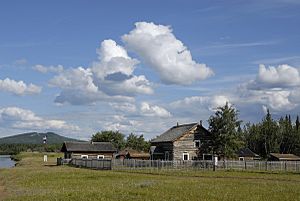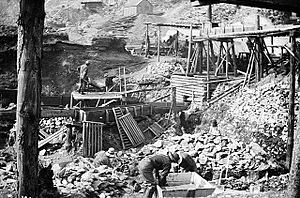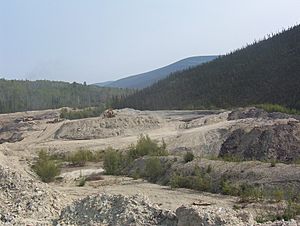History of Yukon facts for kids
The history of the Yukon is a long and exciting journey! It began around 20,000 years ago when the first people, called Paleo-Indians, arrived. They crossed a land bridge called Beringia that connected Asia and North America.
Later, in the 1700s, Russian explorers started trading with the First Nations people along the coast of Alaska. Their trade routes soon reached into the Yukon. By the 1800s, traders from the Hudson's Bay Company were also active in the area. The Yukon was once part of a larger region called the North-Western Territory. In 1870, the United Kingdom gave this territory to Canada. It then became known as the North-West Territories.
A huge change happened in 1896 when gold was found in the Klondike region. This led to the famous Klondike Gold Rush, bringing many gold seekers to the area. Because so many people arrived, the western part of the North-West Territories became its own territory in 1898. It was named the Yukon Territory. Even after the gold rush ended around 1900, mining continued in the early 20th century. During World War II, the Alaska Highway was built through the Yukon. This road helped transport supplies to Alaska. In 1953, the capital of the territory moved from Dawson City to Whitehorse. Since the late 1900s, many First Nations in Yukon have been working with the Canadian government on land claim agreements.
Contents
Early Yukon History: Ancient Times to AD 800
Scientists have found signs of very old human life in the Yukon. Some animal bones found in the Old Crow area show signs of being changed by humans. These bones are thought to be between 25,000 and 40,000 years old. The central and northern parts of the Yukon were not covered by ice during the last Ice Age. This area was part of Beringia, a large land bridge.
Around the year AD 800, a large volcanic eruption happened. It was at Mount Churchill, near the border with Alaska. This eruption covered the southern Yukon with a thick layer of ash. You can still see this ash layer along the Klondike Highway today. Yukon First Nations stories tell of all the animals and fish dying because of this ash. Some experts believe that the eruption might have caused some Athabaskan-speaking peoples to move south. They eventually settled in what is now the southwestern United States. After this time, people started using bows and arrows for hunting instead of older tools like atlatls.
Ancient Trade and Animals
People in the Yukon developed large trading networks. The Tlingit people from the coast traded with First Nations groups living inland. Coastal people traded things like eulachon oil. Inland groups traded native copper and furs. The Yukon was once part of the ancient land of Beringia. This area was home to many huge, ancient animals. These included woolly mammoths, American lions, giant beavers, and short-faced bears.
First Nations: Original Peoples of Yukon
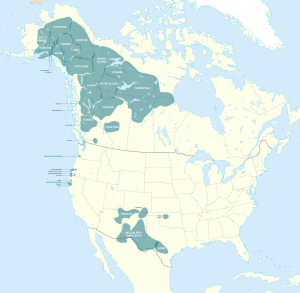
At the start of the 1800s, many First Nations people lived in the Yukon. Some historians believe there were about 8,000 people. Other estimates suggest between 7,000 and 9,000 people. By 1830, one estimate put the number at about 4,700.
Most of the Yukon was home to various Athabaskan tribes. In the north, near the Peel River and Porcupine River, lived the Gwich'in people. The Hän people lived in the middle of the Yukon River area, near Alaska. The Northern Tutchone lived in the central Yukon, around the Pelly River and Stewart River. The Southern Tutchone were in the southwest. In the southeast, near the Liard River, lived the Kaska Natives. The Tagish lived in the south, near the lakes at the top of the Yukon River. The Upper Tanana people lived in the southwest, near the start of the White River.
Besides Athabaskan groups, the Inuit people lived on the Arctic coast of the Yukon, including Herschel Island. In the south, along the Teslin River, lived the continental Tlingit people. Their language is related to the Athabaskan languages. The snowy area around Mount Saint Elias in the far southwest of the Yukon was not settled by people.
19th Century: Fur Trade and Gold Discoveries
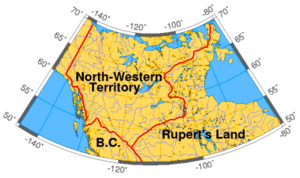
European explorers began to enter the Yukon in the early 1800s. They came for the fur trade. Traders from the Hudson's Bay Company used two main routes to get into the Yukon. They built trading posts along the way. The northern route started at Fort McPherson, Northwest Territories and went over the mountains to the Bell and Porcupine Rivers, leading to the Yukon River. The southern route started at Fort Laird. It followed the Liard River to Frances Lake and then the Pelly River to the Yukon River.
In 1845, John Bell crossed into the Yukon River area. He followed the Porcupine River to where it met the Yukon River. This became the site of Fort Yukon. Soon after, Alexander Hunter Murray set up trading posts at Lapierre House (1846) and Fort Yukon (1847). Murray drew pictures of the posts and people. His writings give us a good look at the local Gwich’in First Nation people.
Even though Fort Yukon was in Russian Alaska, the Hudson's Bay Company traded there. They were forced to leave in 1869 after the Alaska Purchase by the United States. A new post, Rampart House, was built upstream. But it was also found to be just inside Alaska. The Gwich’in people, especially under Sahneuti, cleverly traded with both the Hudson's Bay Company and American traders.
Around the same time, Robert Campbell explored much of the southern Yukon. He built Fort Frances (1842) on Frances Lake and Fort Selkirk, Yukon (1848). In 1852, Tlingit warriors attacked Fort Selkirk. They were upset because the fort interfered with their trade. Fort Selkirk was left empty until 1889.
Anglican and Roman Catholic missionaries also came to the Yukon. William Carpenter Bompas became the first Anglican bishop of the Yukon. Catholic missionaries were mainly from the Oblates of Mary Immaculate. They still have a presence in the Yukon today.
In 1859, Robert Kennicott led an expedition to collect animal and plant samples. He explored the Mackenzie and Yukon River valleys. Kennicott encouraged fur traders to send specimens to the Smithsonian museum. In 1865, the Western Union Telegraph Expedition tried to find a route for a telegraph line. It would connect North America and Russia across the Bering Sea. Kennicott was the main scientist for this trip. He died during the journey up the Yukon River. But his work helped bring the Yukon to the world's attention.
In 1870, the United Kingdom officially gave the North-Western Territory to the government of Canada.
The Search for Gold Begins
Rumours of gold in the Yukon had been around for a while. But not much was done about them. After the Alaska purchase, American traders started working along the upper Yukon River. Three miners, Alfred Mayo, Jack McQuesten, and Arthur Harper, heard these rumours. They worked as traders but were really interested in finding gold. In 1874, Mayo and McQuesten built Fort Reliance. It was a few miles downstream from where Dawson City would later be. Miners slowly arrived, finding gold in many places, but usually not enough to make them rich.
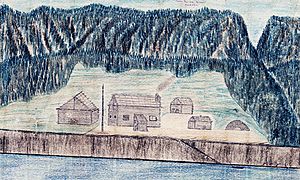
In 1885, a good amount of gold was found on the Stewart River. McQuesten convinced the Alaska Commercial Company to focus on miners, not just furs. The next year, more gold was found on the Fortymile River. A new trading post, Forty Mile, Yukon, was built there.
At the same time, the US Army sent Lieutenant Frederick Schwatka to explore the Yukon River. His group crossed the Chilkoot Pass. They built rafts and floated down the Yukon River to the Bering Sea. They named many places along the way. Schwatka's trip worried the Canadian government. So, they sent their own expedition in 1887, led by George Mercer Dawson. William Ogilvie, a surveyor who became famous during the Klondike Gold Rush, was part of this trip. He surveyed the border with Alaska.
In 1894, the Canadian government was concerned about the many American miners. They also worried about the liquor trade. So, they sent Inspector Charles Constantine of the North-West Mounted Police to check on the Yukon.
In 1895, the Yukon District was created from the North-West Territories. The population grew very fast because of the gold rush. Three years later, on June 13, 1898, the Yukon became its own territory. This happened with the passing of the Yukon Act.
Klondike Gold Rush: A Golden Era
The Klondike Gold Rush was the most important event in Yukon's history. In August 1896, a group led by Skookum Jim Mason found gold in Bonanza Creek. This creek flows into the Klondike River. News of the discovery spread in 1897. An estimated 30,000 to 40,000 people bravely faced many challenges to reach the Klondike gold fields. This happened in the winter and spring of 1897-1898. With so many American gold seekers arriving, the Canadian government decided to create a separate territory. This helped them control the situation better.
By 1901, many people had left. The Census showed the territory's population was 27,219. This number wasn't reached again until 1991. The rush of people greatly encouraged searching for minerals in other parts of the Yukon. It led to smaller gold rushes in Atlin, British Columbia and Nome, Alaska. It also caused many mini-rushes. The need for transportation to the gold fields led to the building of the White Pass and Yukon Route railway.
20th Century: Development and Change
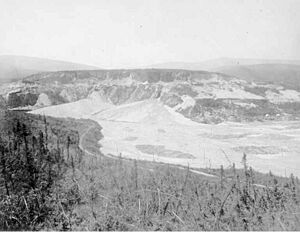
Around the early 1900s, the US Army started building a telegraph line. It ran through Tanacross and crossed the Tanana River. The line continued north, past Ketchumstuck. Then it split, one part going to Fairbanks and the other to Eagle. The line's direct impact was short. By 1915, most of it was abandoned. By 1926, only 11 miles remained. In 1912, the Protestant Episcopal Church bought the telegraph station at Tanana Crossing. They set up St. Timothy's mission there.
After the gold rush, the Yukon's population dropped sharply. It reached a low of 4,157 people in 1921. The population stayed low until the 1940s. This happened even though other mining areas developed. These included silver mining near Mayo, gold in the Kluane Lake area, and copper near Whitehorse. In the Klondike, individual miners' claims were bought up. Companies like the Guggenheim's Yukon Gold Corporation took them over. They used huge floating dredges to find gold. The Yukon Consolidated Gold Company continued dredging for gold until the 1960s. There was a short period of wealth in the 1930s when the price of gold went up.
By 1920, the elected territorial council had only three members. The territory was directly ruled by the Gold Commissioner. This was a federal government worker who reported to the Minister of the Interior.
World War II and Modern Highways
The next big event in Yukon's history was the building of the Alaska Highway. This happened during World War II. After the war, the Canadian Government rebuilt the highway. This opened up the territory to road traffic. The Alaska Highway has been very important in connecting people and cultures. Today, it is still a beautiful and well-kept road all year. The war also led to the building of several airfields. These were part of the Northwest Staging Route. However, the arrival of many highway construction workers from the south had a sad effect on some First Nations. Many people died from diseases they had no immunity to.
On April 1, 1953, the capital of the territory moved from Dawson City to Whitehorse.
Other highways were built in the 1950s and 1960s. This led to the decline of riverboats, which had been the main way to travel until the 1960s. In the 1950s, the White Pass & Yukon Route started using containerized shipping. Mining also came back to life. This included copper mining in Whitehorse, silver and lead in Keno and Elsa, and asbestos in Clinton Creek. The world's largest open-pit zinc and lead mine opened in Faro in the early 1970s. Gold mining returned to the Klondike and other areas when gold prices rose sharply in the late 1970s.
In the 1980s and 1990s, mining slowed down. The role of the government grew a lot, with more money coming from the federal government. In 1978, political parties were introduced to the Yukon Legislative Assembly. In October 1979, the Yukon gained responsible government. This meant local leaders had more control. Also, in the 1970s, First Nations began working on land claims negotiations. This led to a big agreement called the "Umbrella Final Agreement" in 1992. Most First Nations have signed agreements. But land claims and self-government talks are still happening today. First Nations are now seen as a fourth level of government. The way these different governments work together is still being figured out. Today, the Canadian government is investing in clean energy and protecting the environment in the Yukon. One goal is to involve First Nations, Inuit, and Métis peoples more in the northern economy.
21st Century: Modern Yukon
In 2003, the Yukon Territory officially changed its name. The words "the" and "Territory" were dropped from the official name. However, people in the Yukon government and among its residents still often use "the Yukon."
The Yukon was affected by the COVID-19 pandemic and the lockdowns that were put in place to control it.


